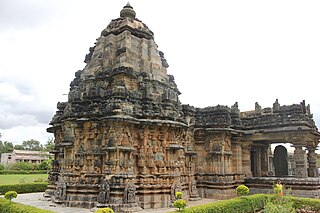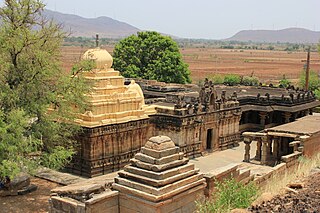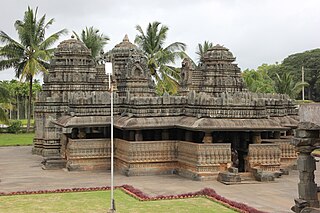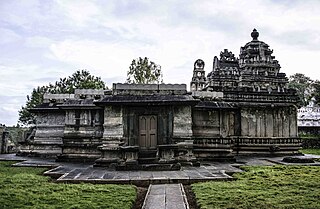
The Hoysala Empire was a Kannadiga power originating from the Indian subcontinent that ruled most of what is now Karnataka, India between the 10th and the 14th centuries. The capital of the Hoysalas was initially located at Belur but was later moved to Halebidu.
The origin of Vijayanagara empire is a controversial topic in South Indian history, with regard to the linguistic affiliation of the founding dynasty, the Sangama family. The Vijayanagara Empire rose to power in southern India in the 14th century CE. Over the past decades historians have expressed differing opinions on whether the empire's founders, Harihara I and Bukka I, were of Kannada or Telugu origin. There are various opinions about role of the Vidyaranya, the Hindu saint and guru of Harihara I and Bukka I in the founding of the Vijayanagara empire.

The Veera Narayana temple, also referred to as the Viranarayana temple of Belavadi, is a triple Hindu temple with a complex Hoysala architecture completed around 1200 CE. Close to Halebidu, this is a better preserved large Hoysala monument found in the small village of Belavadi, Chikkamagaluru district of Karnataka, India.

The Ranganthaswamy temple in Srirangapatna, in the Mandya district of Karnataka state, India, is dedicated to the Hindu god Ranganatha. It is one of the five important pilgrimage sites of Sri Vaishnavism along the river Kaveri for devotees of Ranganatha. These five sacred sites are together known as Pancharanga Kshetrams in Southern India. Since Srirangapatna is the first temple starting from upstream, the deity is known as Adi Ranga. The town of Srirangapatna, which derives its name from the temple, is located on an island in the river Kaveri.

The Amruteshvara temple also spelt "Amrutesvara" or "Amruteshwara", is located in the village of Amruthapura, 67 km north of Chikmagalur town in the Chikkamagaluru district of the Karnataka state, India. Located 110 km from Hassan and 50 km from Shimoga on NH 206, Amruthapura is known for the Amruteshvara temple. The temple was built in 1196 C.E. by Amrutheshwara Dandanayaka under Hoysala King Veera Ballala II.

Bucesvara temple, also referred to as the Buceswara, Bucheshwara or Bhucheshvara temple, is a 12th century Hindu temples in Koravangala village, Karnataka, India. The most sophisticated historical temple in the village, it is considered to be the flag-bearer of Hoysala architecture and was built by a wealthy patron named Buchi during the reign of king Ballala.

The Kalleshvara temple is located in Aralaguppe, a village in the Tiptur taluk of Tumkur district, in the Indian state of Karnataka.

The Kalleshwara temple is located in the town of Hire Hadagali of the Hoovina Hadagalitaluk in Bellary district of Karnataka state, India.

The Kaitabheshvara temple is located in the town of Kubatur, near Anavatti in the Shimoga district of Karnataka state, India. The temple was constructed during the reign of Hoysala King Vinayaditya around 1100 AD. The Hoysala ruling family was during this time a powerful feudatory of the imperial Western Chalukya Empire ruled by King Vikramaditya VI. According to the Archaeological Survey of India, the architectural signature of the temple is mainly "Chalukyan". Art historian Adam Hardy classifies the style involved in the construction of the temple as "Later Chalukya, non mainstream, far end of spectrum". The building material used is soapstone The temple is protected as a monument of national importance by the Archaeological Survey of India.

Kalleshvara temple is located in the town of Bagali near to Harpanahalli town in the Davangere district of Karnataka state, India.

The Kedareshvara temple is located in the town of Balligavi, near Shikaripura in the Shimoga district of Karnataka state, India. Dotted with centres of learning (agrahara), Balligavi was an important city during the 11th - 12th century Western Chalukya rule. The term Anadi Rajadhani used in medieval inscriptions to describe this town tells a tale of great antiquity. Art historian Adam Hardy classifies the style involved in the construction of the temple as "Later Chalukya, non mainstream, relatively close to mainstream". He dates the temple to late 11th century, with inscriptional evidence of additions made up to 1131, by the Hoysalas during their control over the region. The building material used is soapstone. The Archaeological Survey of India classifies the style of architecture as distinctly Hoysala. The Hoysala ruling family was during this period a powerful feudatory of the imperial Western Chalukya Empire, gaining the trappings of independence only from the period of King Vishnuvardhana. The temple is protected as a monument of national importance by the Archaeological Survey of India.

The Nageshvara-Chennakeshava temple complex, sometimes referred to as the Nagesvara and Chennakesava temples of Mosale, are a pair of nearly identical Hindu temples in the village of Mosale near Hassan city, Karnataka, India. One for Shiva, other for Vishnu, this pair is a set of highly ornamented stone temples, illustrating the Hoysala architecture. These temples also include panels of artwork related to the goddess tradition of Hinduism (Shaktism) and Vedic deities. Another notable feature of these temples is the artwork in their ceilings, how the shilpins (artisans) integrated the historic pre-Hoysala architectural innovations from the Chalukya era. Further, the temples include north Indian Bhumija and south Indian Vesara aedicules on the outer walls above the panels. It is unclear when this temple pair was built, but given the style and architectural innovations embedded therein, it was likely complete before 1250 CE.

Kedareshwara Temple is a Hoysala era construction in the historically important town of Halebidu, in the Hassan district of Karnataka state, India. It is located a short distance away from the famous Hoysaleswara Temple. The temple was constructed by Hoysala King Veera Ballala II and his Queen Ketaladevi, and the main deity is Ishwara. The temple is protected as a monument of national importance by the Archaeological Survey of India.

The Rameshvara temple is a 12th-century Shiva temple in Kudli, Shimoga district, Karnataka India. It is an early non-ornate, Hoysala construction with simpler Vesara style. The village of Koodli – also spelled Kudli, Kudali – was a major town through the 14th-century and of great antiquity, with ruins of over eight major Hindu temples and monasteries. It is located about 18 kilometres (11 mi) north-east of Shimoga city, the district headquarters. The town gets its name because it is situated at the confluence of the Tunga and Bhadra tributaries that form the Tungabhadra river.

The Saumyakeshava temple at Nagamangala was constructed in the 12th century by the rulers of the Hoysala empire. Nagamangala is a town in the Mandya district of Karnataka state, India. It is located 62 km from the historically important town Mysore, on the Srirangapatna-Sira highway. Historically, Nagamangala came into prominence during the rule of Hoysala King Vishnuvardhana when it became an important center of Vaishnava faith and received patronage from one of his queens, Bommaladevi. During the rule of Veera Ballala II, Nagamangala prospered as an agrahara and had the honorific Vira Ballala Chaturvedi Bhattaratnakara. The temple is protected as a monument of national importance by the Archaeological Survey of India.

Akkana Basadi is a Jain temple built in 1181 A.D., during the rule of Hoysala empire King Veera Ballala II. The basadi was constructed by the devout Jain lady Achiyakka, wife of Chandramouli, a Brahmin minister in the court of the Hoysala king. The main deity of the temple is the twenty-third Jain Tirthankar Parshwanath. The temple is protected as a monument of national importance by the Archaeological Survey of India. It is part of a Archaeological Survey of India Adarsh Smarak Monument along with other temples in the Shravanabelagola group of monuments.

The Group of temples at Talakad, located about 45 km south-east of the culturally important city of Mysore in the Karnataka state of India are ancient Hindu temples built by multiple South Indian dynasties. Archaeological excavations of the sand dunes at Talakad have shown the existence of several ruined temples built during the rule of the Western Ganga dynasty (c.345-999). However, according to historian I. K. Sarma, only two temples, the Pataleshvara and Maraleshvara, built during the reign of King Rachamalla Satyavakya IV (r.975-986) are intact. According to the Archaeological Survey of India (ASI), the Vaidyeshvara temple, the largest, the most intact and ornate of the group bears Ganga-Chola-Hoysala architectural features. Its consecration is assignable to the 10th century with improvements made up to the 14th century. According to the art historian Adam Hardy, the Kirtinarayana temple was built in 1117 A.D. by the famous Hoysala King Vishnuvardhana to celebrate his victory over the Cholas in the battle of Talakad. It has currently been dismantled by the ASI for renovation. Only its mahadwara is intact. The Sand dunes of Talakad are protected by the Karnataka state division of the ASI. The Vaidyeshvara and Kirtinarayana temples are protected as monuments of national importance by the central Archaeological Survey of India.

Shantinatha Basadi, a Jain temple dedicated to the sixteenth Tirthankar Shantinatha is located in the historically important temple town of Jinanathapura near Shravanabelagola. It is a village in Channarayapatna taluk in the Hassan district of Karnataka state, India.

The Arakeshvara Temple, dedicated to the Hindu god Shiva, is located in the village of Hole Alur in the Chamarajanagar district of Karnataka state, India. According to the historian Sarma, the temple which dates back to the middle of the 10th century rule of the Western Ganga Dynasty appears to have been renovated in later periods. It was constructed by King Butuga II around 949 A.D. to celebrate his victory over the Cholas of Tanjore in the historically important battle of Takkolam. It was a military engagement between crown prince Rajaditya, son of the Chola King Parantaka I, and King Butaga II. The temple is protected as a monument of national importance by the central Archaeological Survey of India.

Veeranarayana Temple in Gadag city is a Hindu temple known to have been built around c.1117 by the Hoysala empire King Vishnuvardhana. Gadag city is the administrative headquarters of Gadag district in the state of Karnataka, India. The primary deity in temple is the Hindu god Narayana. The Veeranarayana temple is a protected monument under the Karnataka state division of the Archaeological Survey of India.






















